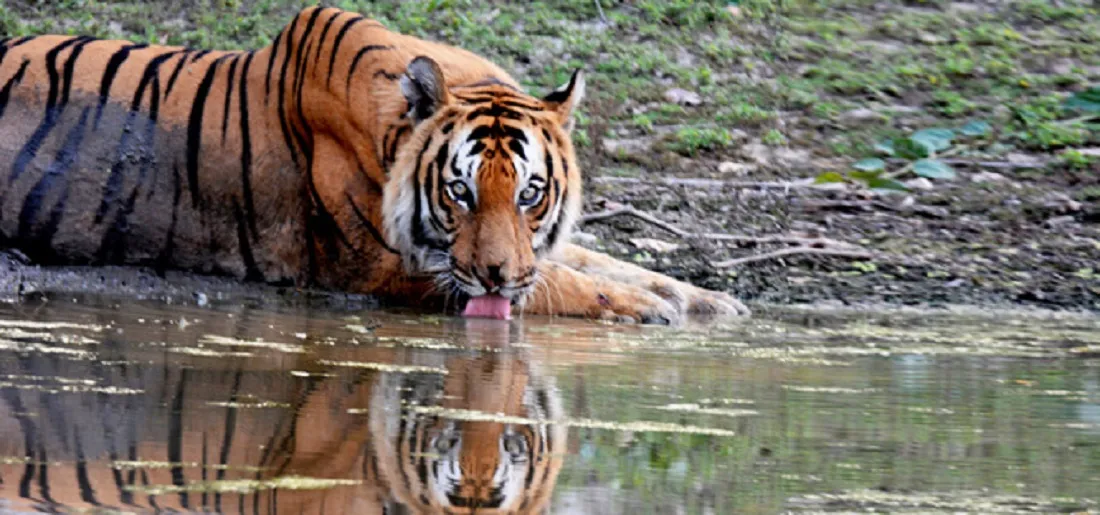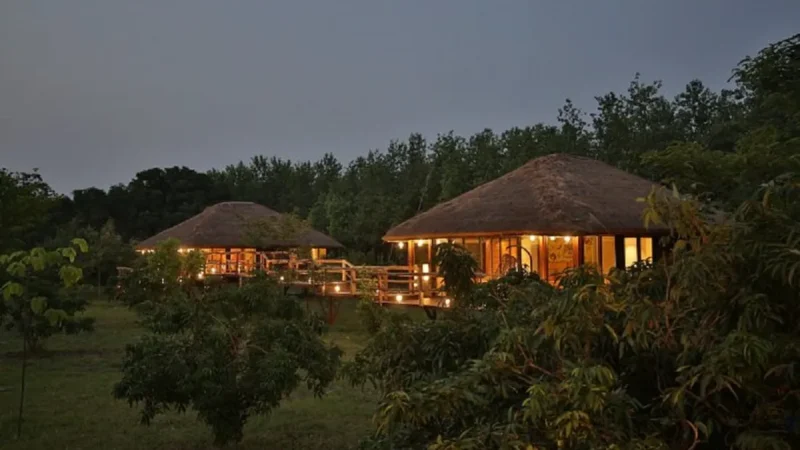Dudhwa National Park & Tiger Reserve

Dudhwa National Park Tiger Reserve-
Welcome to Dudhwa National Park & Tiger Reserve, a pristine haven in the Terai region of Uttar Pradesh, India. Spread across a vast expanse of over 1,280 square kilometers, this protected area is renowned for its rich biodiversity, unique ecosystems, and majestic tigers.
In this blog, we invite you to embark on a virtual journey through Dudhwa National Park & Tiger Reserve, where the wild reigns supreme. Let’s delve into the captivating landscapes, the incredible wildlife, and the conservation efforts that make this reserve a treasure trove for nature enthusiasts and wildlife lovers alike.
Discover the Wilderness:
Immerse yourself in the beautiful wilderness of Dudhwa National Park & Tiger Reserve, where nature’s splendor unfolds at every turn. This protected area is a sanctuary for diverse ecosystems, offering a haven for countless species of flora and fauna. Let’s embark on a journey to discover the mesmerizing wilderness of Dudhwa.
- Lush Forests: As you step into Dudhwa National Park, you’ll be greeted by a dense expanse of lush forests. The park is predominantly covered in Sal forests, characterized by towering Sal trees that create a verdant canopy. These forests shelter wildlife, including tigers, leopards, deer, and numerous bird species. Stroll along the forest trails, and allow the serene ambiance to envelop you.
- Expansive Grasslands: The grasslands of Dudhwa National Park add a touch of magic to the landscape. These sprawling meadows, interspersed with wetlands and marshes, are home to the endangered Bengal Florican, a magnificent bird known for its elaborate courtship dance. The grasslands also attract other avian species, such as the Sarus Crane, the Great Indian Bustard, and many migratory birds during winter. Witness the gentle swaying of grasses and the chorus of bird songs that fill the air.
- Tranquil Lakes and Rivers: Dudhwa National Park has serene lakes and meandering rivers that enhance its natural beauty. The tranquil lakes, such as Sathania, Banke Tal, and Bhadi Tal, offer a picturesque setting for birdwatching and observing aquatic life. They provide vital water sources for wildlife, attracting animals like elephants, deer, and water birds. Like the Suheli and Mohana, the rivers weave through the park, sustaining the ecosystems and offering stunning vistas along their banks.
- Wetland Ecosystems: The wetlands of Dudhwa National Park form a crucial part of its biodiversity. These marshy areas, rich vegetation, and abundant water sources support many aquatic plants, insects, and amphibians. They serve as breeding grounds for several species of fish, turtles, and even the rare Gharial, a critically endangered crocodilian species. Explore these wetland ecosystems and witness the delicate balance of life within them.
- Floral Delights: Dudhwa National Park is a paradise for botany enthusiasts. The diverse range of flora includes not only the dominant Sal trees but also a variety of other tree species like Teak, Jamun, and Mahua. The forest floor is adorned with vibrant undergrowth, including ferns, wildflowers, and medicinal plants. Keep an eye out for rare and endemic plant species that add to the ecological richness of the park.
- Night Safari: The wilderness of Dudhwa National Park comes alive after dark. Experience the thrill of a night safari, where you can witness the nocturnal wonders of the park. Guided by experienced naturalists, venture into the forest’s depths to catch glimpses of elusive creatures such as owls, civets, hyenas, and maybe even the elusive Royal Bengal Tiger. Listen to the symphony of sounds as the nocturnal animals awaken and reveal their hidden world.
Majestic Tigers:
Within the enchanting realms of Dudhwa National Park & Tiger Reserve, prepare to encounter the mesmerizing and majestic tigers that call this pristine wilderness their home. As one of the most iconic and revered creatures on Earth, tigers symbolize strength, grace, and the untamed spirit of the wild. Let’s delve into the world of Dudhwa’s tigers and unravel the wonders they behold.
- Royal Bengal Tigers: Dudhwa National Park is renowned for its thriving population of Royal Bengal Tigers, also known as Indian tigers. These regal felines are the most prominent members of the cat family and possess a striking appearance with their distinctive orange coats adorned with dark stripes. Explore their fascinating behaviors, territorial instincts, and the delicate balance of their ecosystem within the park.
- Tiger Conservation: Dudhwa National Park plays a crucial role in the conservation of tigers. The reserve is dedicated to protecting these magnificent creatures from the threats they face, including habitat loss, poaching, and human-wildlife conflicts. Discover the conservation efforts undertaken by the park authorities and the local communities to ensure the region’s survival and thriving population of tigers.
- Tiger Spotting: Embark on exhilarating tiger safaris within Dudhwa National Park, accompanied by experienced guides and naturalists who deeply understand the tigers’ behavior and habitat. Traverse the park’s diverse landscapes, including dense forests, grasslands, and riverbanks, as you watch for signs of these elusive predators. Feel your heart race with anticipation as you catch sight of a tiger in its natural habitat, an experience that will stay etched in your memory forever.
- Wildlife Photography: Dudhwa National Park offers incredible opportunities for wildlife photography, especially when it comes to capturing the majestic tigers. Whether you are an amateur photographer or a seasoned professional, the park’s scenic beauty and the presence of these magnificent predators provide a captivating subject for your lens. Capture their awe-inspiring sight, stealthy movements, and mesmerizing gaze as you strive to freeze their raw power in a photograph.
- Understanding Tiger Behavior: Delve into the intricate world of tiger behavior and ecology. Learn about their hunting techniques, territoriality, and vital role in maintaining the balance of the ecosystem. Gain insights into their social structure, mating rituals, and challenges in a rapidly changing world. Understanding their behavior will deepen your appreciation for these remarkable creatures and the importance of conserving their habitats.
- Conservation Awareness: Dudhwa National Park & Tiger Reserve is a sanctuary for tigers and a platform for raising awareness about their conservation. Engage in educational programs and interpretive exhibits that shed light on the importance of tiger conservation and each individual’s role in protecting these endangered species. By spreading awareness, we can contribute to preserving their habitats and ensure a future where tigers continue to roam free.
Biodiversity Hotspot:
Dudhwa National Park & Tiger Reserve is renowned for its majestic tigers and is recognized as a biodiversity hotspot, teeming with a remarkable variety of flora and fauna. The park’s diverse ecosystems, encompassing forests, grasslands, wetlands, and rivers, provide a thriving habitat for numerous iconic and lesser-known species. Let’s explore the incredible biodiversity that makes Dudhwa a haven for nature enthusiasts and conservationists.
- Endangered Species: Dudhwa National Park is home to several endangered species, making it a critical stronghold for their conservation. One such species is the Indian rhinoceros, which finds refuge in the grasslands and wetlands of the park. The population of the rhinoceros has been successfully restored through dedicated conservation efforts. Other endangered species in the park include the swamp deer (Barasingha) and the Gharial, a rare crocodilian species. Witnessing these magnificent creatures in their natural habitat is a testament to the park’s commitment to preserving biodiversity.
- Migratory Birds: Dudhwa National Park is a paradise for birdwatchers, attracting many avian species yearly. The park’s wetlands and water bodies serve as crucial stopovers for migratory birds, providing them a haven during their long journeys. Witness the spectacular sight of flocks of birds descending upon the park, including Sarus Cranes, Painted Storks, Bar-headed Geese, and a multitude of waterfowl species. These winged wonders’ musical calls and vibrant plumage create a symphony of colors and sounds in the park’s ecosystem.
- Mammals: The diverse landscapes of Dudhwa National Park support an affluent mammal population. Apart from tigers and rhinoceroses, the park is home to iconic species such as elephants, leopards, sloth bears, deer, wild boars, and jackals. These mammals play integral roles in maintaining the park’s ecological balance, contributing to seed dispersal, herbivory, and predation dynamics. Embark on wildlife safaris to catch glimpses of these majestic creatures, observing their behaviors and admiring their innate beauty.
- Reptiles and Amphibians: Dudhwa National Park is also a haven for reptiles and amphibians, representing a lesser-known aspect of its biodiversity. Explore the wetlands and water bodies to encounter species like the Indian python, king cobra, monitor lizards, and various frogs and toads. These creatures play vital roles in controlling insect populations, serving as indicators of the overall health of the park’s ecosystems.
- Flora and Medicinal Plants: Dudhwa National Park boasts a rich floral diversity, with many plant species contributing to the park’s intricate web of life. The park’s forests are a sight to behold, from towering Sal trees to majestic Teaks and vibrant undergrowth. Some plant species found in Dudhwa possess medicinal properties and have been traditionally used by local communities for centuries. Explore the park’s flora, learning about these plants’ ecological significance and cultural importance.
- Conservation Efforts: The biodiversity of Dudhwa National Park is a testament to the ongoing conservation efforts to preserve its ecological balance. The park’s authorities work tirelessly to protect endangered species, restore habitats, and engage local communities in sustainable conservation practices. Discover the initiatives to mitigate threats such as poaching, habitat fragmentation, and human-wildlife conflicts. By supporting these conservation efforts, we contribute to the long-term survival of the park’s diverse flora and fauna.






